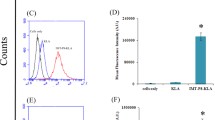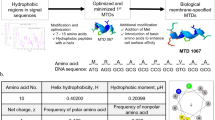Abstract
Purpose.
We examined the ability of a protein transduction domain (PTD), YARA, to penetrate in the skin and carry a conjugated peptide, P20. The results with YARA were compared to those of a well-known PTD (TAT) and a control, nontransducing peptide (YKAc). The combined action of PTDs and lipid penetration enhancers was also tested.
Methods.
YARA, TAT, YKAc, P20, YARA-P20, and TAT-P20 were synthesized by Fmoc chemistry. Porcine ear skin mounted in a Franz diffusion cell was used to assess the topical and transdermal delivery of fluorescently tagged peptides in the presence or absence of lipid penetration enhancers (monoolein or oleic acid). The peptide concentrations in the skin (topical delivery) and receptor phase (transdermal delivery) were assessed by spectrofluorimetry. Fluorescence microscopy was used to visualize the peptides in different skin layers.
Results.
YARA and TAT, but not YKAc, penetrated abundantly in the skin and permeated modestly across this tissue. Monoolein and oleic acid did not enhance the topical and transdermal delivery of TAT or YARA but increased the topical delivery of YKAc. Importantly, YARA and TAT carried a conjugated peptide, P20, into the skin, but the transdermal delivery was very small. Fluorescence microscopy confirmed that free and conjugated PTDs reached viable layers of the skin.
Conclusions.
YARA and TAT penetrate in the porcine ear skin in vitro and carry a conjugated model peptide, P20, with them. Thus, the use of PTDs can be a useful strategy to increase topical delivery of peptides for treatment of cutaneous diseases.
Similar content being viewed by others
References
1. M. R. Prausnitz, S. Mitragotri, and R. Langer. Current status and future potential of transdermal drug delivery. Nat. Rev. Drug Discov. 3:115–124 (2004).
2. K. C. Madison. Barrier function of the skin: “La Raison d’etre” of the epidermis. J. Invest. Dermatol. 121:231–241 (2003).
3. B. Barry. Breaching the skin’s barrier to drugs. Nat. Biotechnol. 22:165–167 (2004).
4. P. Karande, A. Jain, and S. Mitragotri. Discovery of transdermal penetration enhancers by high-throughput screening. Nat. Biotechnol. 22:192–197 (2004).
5. G. Cevc, A. Schatzlein, and G. Blume. Transdermal drug carriers: basic properties, optimizations and transfer efficiency in the case of epicutaneously applied peptides. J. Control. Rel. 36:3–16 (1995).
6. B. Godin and E. Touitou. Mechanism of bacitracin permeation enhancement through the skin and cellular membranes from an ethosomal carrier. J. Control. Rel. 94:365–379 (2004).
7. O. Pillai, V. Nair, and R. Panchagnula. Transdermal iontophoresis of insulin: IV. Influence of chemical enhancers. Int. J. Pharm. 269:109–120 (2004).
8. Y. N. Kalia, A. Naik, J. Garrison, and R. H. Guy. Iontophoretic drug delivery. Adv. Drug Deliv. Rev. 56:619–658 (2004).
9. S. Mitragotri. Synergistic effect of enhancers for transdermal drug delivery. Pharm. Res. 17:1354–1359 (2000).
10. H. D. C. Smyth, G. Becket, and S. Mehta. Effect of permeation enhancer pretreatment on the iontophoresis of luteinizing hormone releasing hormone (LHRH) through human epidermal membrane (HEM). J. Pharm. Sci. 9:11296–11307 (2002).
11. R. R. Boinpally, S. L. Zhou, G. Devraj, P. K. Anne, S. Poondru, and B. R. Jasti. Iontophoresis of lecithin vesicles of clyclosporin A. Int. J. Pharm. 274:185–190 (2004).
12. M. Lindgren, M. Hallbrink, A. Prochiantz, and U. Langel. Cell-penetrating peptides. Trends Pharmacol. Sci. 21:99–103 (2000).
13. S. R. Schwarze and S. F. Dowdy. In vivo protein transduction: intracellular delivery of biologically active proteins, compounds and DNA. Trends Pharmacol. Sci. 21:45–48 (2000).
14. M. Lundberg, S. Wikstrom, and M. Johansson. Cell surface adherence and endocytosis of protein transduction domains. Mol. Ther. 8:143–150 (2003).
15. E. L. Snyder and S. F. Dowdy. Cell penetrating peptides in drug delivery. Pharm. Res. 21:389–393 (2004).
16. J. Zaro and W. C. Shen. Quantitative comparison of membrane transduction and endocytosis of oligopeptides. Biochem. Biophys. Res. Commun. 307:241–247 (2003).
17. S. R. Schwarze, A. Ho, A. Vocero Akbani, and S. F. Dowdy. In vivo protein transduction: delivery of a biologically active protein into the mouse. Science 285:1569–1572 (1999).
18. C. R. Flynn, P. Komalavilas, D. Trssier, J. Thresher, E. E. Niederkofler, C. M. Dreiza, R. W. Nelson, A. Panitch, L. Joshi, and C. M. Brophy. Transduction of biologically active motifs of the small heat shock related protein HSP20 leads to relaxation of vascular smooth muscle. FASEB J. 17:1358–1360 (2003).
19. V. P. Torchilin and T. S. Levchenko. TAT-liposomes: a novel intracellular drug carrier. Curr. Prot. Pept. Sci 4:133–140 (2003).
20. S. Console, C. Marty, C. García-Escheverría, R. Schwendener, and K. Ballmer-Hefer. Antennapedia and HIV transactivator (TAT) “protein transaction domains” promote endocytosis of high molecular weight cargo upon binding to cell surface glycosaminoglycans. J. Biol. Chem. 278:35109–35114 (2003).
21. D. Derossi, S. Calvet, A. Trembleau, A. Brunissen, G. Chassaing, and A. Prochiantz. Cell internalization of the third helix of Antennapedia homeodomain is receptor-independent. J. Biol. Chem. 271:18188–18193 (1996).
22. E. Vives, P. Brodin, and B. Lebleu. A truncated HIV-1 Tat protein basic domain rapidly translocates through the plasma membrane and accumulates in the cell nucleus. J. Biol. Chem. 272:16010–16017 (1997).
23. J. P. Richard, K. Melikov, E. Vives, C. Ramos, B. Verbeure, M. J. Gait, L. V. Chernomordik, and B. Lebleu. Cell penetrating peptides: a reevaluation of the mechanism of cellular uptake. J. Biol. Chem. 278:585–590 (2003).
24. P. E. G. Thoren, D. Persson, P. Isakson, M. Goksor, A. Onfelt, and B. Norden. Uptake of analogs of penetratin, TAT (48–60) and oligoarginine in live cells. Biochem. Biophys. Res. Commun. 307:100–107 (2003).
25. J. B. Rothbard, S. Garlington, Q. Lin, T. Kirschberg, E. Kreider, P. L. Mcgrane, P. A. Wender, and P. A. Khavari. Conjugation of arginine oligomers to cyclosporin A facilitates topical delivery and inhibition of inflammation. Nat. Med. 6:1253–1257 (2000).
26. J. M. Lim, M. Y. Chang, S. G. Park, N. G. Kang, Y. S. Song, Y. H. Lee, Y. C. Yoo, W. G. Cho, S. Y. Choi, and S. H. Kang. Penetration enhancement in mouse skin and lipolysis in adipocytes by TAT-GKH, a new cosmetic ingredient. J. Cosmet. Sci. 54:483–491 (2003).
27. M. P. M. Schutze-Redelmeier, S. Kong, M. B. Bally, and J. P. Dutz. Antennapedia transduction sequence promotes anti tumor immunity to epicutaneously administered CTL epitopes. Vaccine 22:1985–1991 (2004).
28. A. Ho, S. R. Schwarze, S. J. Mermelstein, G. Waksman, and S. Dowdy. Synthetic protein transduction domains: enhanced transduction potential in vitro and in vivo. Cancer Res. 61:474–477 (2001).
29. D. J. Tessier, P. Komalavilas, B. Liu, C. K. Kent, J. S. Thresher, C. M. Dreiza, A. Panitch, L. Joshi, E. Furnish, W. Stone, R. Fowl, and C. M. Brophy. Transduction of peptides analogs of the small heat shock-related protein HSP20 inhibits intimal hyperplasia. J. Vasc. Surg. 40:106–114 (2004).
30. D. J. Tessier, P. Komalavilas, E. McLemore, J. Thresher, and C. M. Brophy. Sildenafil-induced vasorelaxation is associated with increases in the phosphorylation of the heat shock-related protein 20 (HSP20). J. Surg. Res. 118:21–25 (2004).
31. M. Foldvari and M. E. Baca-Estrada. Z., He, J. Hu, S. Attah-Poku, M. King. Dermal and transdermal delivery of protein pharmaceuticals: lipid-based delivery systems for interferon-α. Biotechnol. Appl. Biochem. 30:129–137 (1999).
32. J. D. Bos and M. M. H. M. Meinardi. The 500 Dalton rule for the skin penetration of chemical compounds and drugs. Exp. Dermatol. 9:165–169 (2000).
33. K. Moser, K. Kriwet, A. Naik, Y. N. Kalia, and R. H. Guy. Passive skin penetration enhancement and its quantification in vitro. Eur. J. Pharm. Bipharm 52:103–112 (2001).
34. R. F. V. Lopez, M. V. L. B. Bentley, M. B. Delgado-Charro, and R. H. Guy. Iontophoretic delivery of 5- aminolevulinic acid (ALA): effect of pH. Pharm. Res. 18:311–315 (2001).
35. R. Alvarez-Román, A. Naik, Y. N. Kalia, H. Fessi, and R. H. Guy. Visualization of skin penetration using confocal laser scanning microscopy. Eur. J. Pharm. Biopharm. 58:301–316 (2004).
36. A. C. Williams and B. W. Barry. Penetration enhancers. Adv. Drug Deliv. Rev. 56:603–618 (2004).
37. T. Ogiso, M. Ywaki, and T. Paku. Effect of various enhancers on transdermal penetration of indomethacin and urea and relationship between penetration parameters and enhancement factors. J. Pharm. Sci. 84:482–488 (1995).
38. M. G. Carr, J. Corish, and O. I. Corrigan. Drug delivery from a liquid crystalline base across Visking and human stratum corneum. Int. J. Pharm. 157:35–42 (1997).
39. P. B. Robbins, S. F. Oliver, S. M. Sheu, P. Goodnough, P. Wender, and P. A. Khavari. Peptide delivery to tissues via reversibly linked protein transduction sequences. Biotechiques 33:190–194 (2002).
40. J. Park, J. Ryu, L. H. Jin, J. H. Bahn, J. A. Kim, C. S. Yoon, D. W. Kim, K. H. Han, W. S. Eum, H. Y. Kwon, T. C. Kang, M. H. Won, J. H. Kang, S. W. Cho, and S. Y. Choi. 9-Polylysine protein transduction domain: enhanced penetration efficiency of superoxide dismutase into mammalian cells and skin. Mol. Cells 13:202–208 (2002).
41. V. H. L. Lee. Enzymatic barriers to peptide and protein absorption. Crit. Rev. Ther. Drug Carrier Syst. 5:69–97 (1988).
42. N. G. Turner, L. Ferry, M. Price, C. Cullander, and R. H. Guy. Iontophoresis of L-poly-lysines: the role of molecular weight? Pharm. Res. 14:1322–1331 (1997).
43. L. J. Weimann. J. Wu. Transdermal delivery of L-poly-lysine by sonomacroporation. Ultasound Med. Biol 28:1173–1180 (2002).
44. J. Y. Fang, W. R. Lee, S. C. Shen, H. Y. Wang, C. L. Fang, and C. H. Hu. Transdermal delivery of macromolecules by erbium: YAG laser. J. Control. Rel. 100:75–85 (2004).
45. P. J. White, R. D. Fogarty, I. J. Liepe, P. M. Delaney, G. A. Werther, and C. J. Wraight. Live confocal microscopy of oligonucleotide uptake by keratinocytes in human skin grafts on nude mice. J. Invest. Dermatol. 112:887–892 (1999).
46. T. F. Zioncheck, S. A. Chen, L. Richardson, M. Mora-Worms, C. Lucas, D. Lewis, J. D. Green, and J. Mordenti. Pharmacokinetics and tissue distribution of recombinant human transforming growth factor beta 1 after topical and intravenous administration in male rats. Pharm. Res. 11:213–220 (1994).
47. S. Frank, B. Stallmeyer, H. Kampfer, and N. Kolbe. J. Pfeilschifter. Leptin enhanes wound re-epithelization and constitutes a direct function of leptin in skin repair. J. Clin. Invest. 106:501–509 (2000).
48. K. Lintner and O. Peschard. Biologically active peptides: from a laboratory bench curiosity to function skin care product. Int. J. Cosmet. Sci. 22:207–218 (2000).
49. C.D. Partidos, A.S. Beignon, F. Mawas, G. Belliard, J.P. Briand, and S. Muller. Immunity under the skin: potential application for topical delivery of vaccines. Vaccine 21:776–780 (2003).
50. H. Schaefer and T. E. Redelmeier. Skin Barrier. Principles of Percutaneous Absorption. Kaerger, Basel, 1996.
51. P. E. Thoren, D. Persson, E. K. Esbjorner, M. Goksor, P. Lincoln, and B. Norden. Membrane binding and translocation of cell penetrating peptides. Biochemistry 43:3471–3489 (2004).
52. K. Ohtake, T. Maeno, H. Ueda, H. Natsume, and Y. Morimoto. Poly-L-arginine predominantly increases the paracelullar permeability of hydrophilic macromolecules across rabbit nasal epithelium in vitro. Pharm. Res. 20:153–160 (2003).
53. K. Ohtake, T. Maeno, H. Ueda, M. Ogihara, A. Natsume, and Y. Morimoto. Poly-L-arginine enhances paracellular permeability via serine/threonine phosphorylation of ZO-1 and tyrosine dephosphorilation of occludin in rabbit nasal epithelium. Pharm. Res. 20:1838–1845 (2003).
54. K. Morita and Y. Myachi. Tight junctions in the skin. J. Dermatol. Sci. 31:81–89 (2003).
Author information
Authors and Affiliations
Corresponding author
Rights and permissions
About this article
Cite this article
Lopes, L., Brophy, C., Furnish, E. et al. Comparative Study of the Skin Penetration of Protein Transduction Domains and a Conjugated Peptide. Pharm Res 22, 750–757 (2005). https://doi.org/10.1007/s11095-005-2591-x
Received:
Accepted:
Published:
Issue Date:
DOI: https://doi.org/10.1007/s11095-005-2591-x




